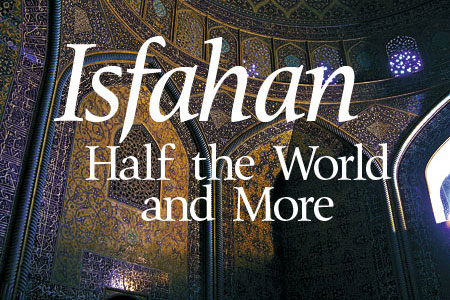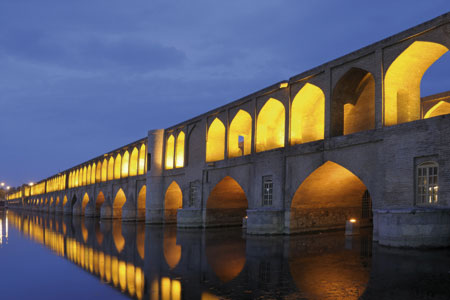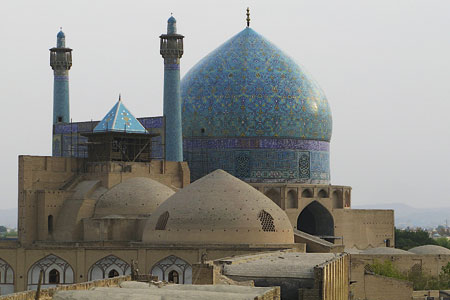
Isfahan - Half the World and More
Issue 80 May 2011
Years of history, stunning architecture and a land immersed in rich, cultural heritage, Muna H. Bilgrami discovers the beauty of Isfahan.
Photography: Christopher Belsten
If you are an aficionado of Middle Eastern and Persian travelogues, you will probably have come across the boastful Farsi slogan ‘Esfahan nesfe jahan’ — ‘Isfahan is half the world’. It’s a charming hyperbole that is quite characteristic of what one might generally conceive of as typically excessive Persian self-regard. So, it is no wonder that the Isfahanis carry great pride of their city, and what a city it is!
Now the third largest city of Iran, with a population approaching two million, its core is a veritable jewel of Islamic art, architecture and planning and the epitome of Persian culture, recognised by UNESCO as a World Heritage Site. Dripping with Seljuk and Safavid heritage from its beautiful turquoise blue tiles, to its handsome bridges across the Zayandeh River, to the stunning Imam Square, Isfahan easily captivated us and held us in her exquisite thrall.
The Zayandeh Ruud (river) that cuts through Isfahan is graced with several bridges, the oldest of which is the 12th century Shahrestan lying further east. We saw the Si-o-Seh Pol or ‘33 Arches’ Bridge, the Chubi and the Khaju. These bridges should be seen both in the day and at night, for the lighting shows off the pleasing patterned order of the bricks and arches of these bridges. Above and below the bridges and in the parklands alongside, Isfahanis thronged: enjoying picnics or promenades in the fresh autumnal evening air.

The architecture of Isfahan is one to be marvelled at — with its plethora of mosques providing plenty of opportunity to do just that. Without doubt one of the most beautiful mosques of the world, Imam Mosque is rich in multi-hued blue mosaic faience and graced by stunning proportions. One could spend hours in this magnificent mosque, tracing the calligraphies that adorn the iwans and drinking in the mosaic faiences; from the geometric, to the arabesque in all those cool heavenly blues, punctuated by bits of yellow from the haft-rangi tiles. Once through its entrance, you suddenly find that the entire mosque complex veers off to the right, for naturally the orientation of the mosque is towards Makkah. This magnificent entrance portal with stalactites was begun in 1611 and took another 18 years before the rest of mosque was finished.

Through the south iwan, we entered the main sanctuary: a huge expanse, with a double layered ceiling on the dome, with the inside ceiling measuring in at a staggering 36.3 metres, and the outside roof reaching 51 metres. One of the special features of this space is the echo. Our guide demonstrated the effect by stamping on the black stone set in the centre of the hall. We counted about 12 echoes, but apparently more can be measured with the right instruments (the guide book said 49!).
The sunken mihrab has a mysterious little window above it, now blocked, the reason for which goes thus: with the square at a different angle to the mosque, there had been concern about establishing the correct direction of qiblah. The architect had a dream: open a little window above the mihrab and the the Ka’ba itself could be seen. Apocryphal or otherwise, it is easy to see how celestial inspiration had a hand in creating such a sacred space.
We were privileged to be able to stay at the historic Abbasi Hotel —formerly a caravanserai built in the early 18th century during the reign of Shah Sultan Hossein (1694-1723 CE) by order of his mother.
Well situated in the heart of Isfahan at the side of Chehar Bagh, this architectural and decorative gem of a hotel is a destination in and of itself. With all the amenities of a world class hotel— including a Qur’an museum— the centrepiece is the courtyard full of flowers, persimmon and quince trees and of course pools and fountains. We relished sitting in this oasis, gazing at the turquoise blue dome of the Mader-e Shah mosque, and listening to the raindrop patter of fountain spray. The autumnal chill in the air at night did not prevent visitors, foreign and local, from dining alfresco in the courtyard, and one evening we supped memorably on a wholesome traditional ‘Aash’ (a thick pottage) under the stars.
All manner of shops are within easy reach of the hotel, from miniature artists, to books, clothing, footware, and the slightly chewy bastani or traditional ice-cream.
The second largest city square in the world (after Tiananmen in China), Imam Square was once called Naqsh-e Jahan or ‘map of the world’ and then Shah Square. This magnificent rectangular square or maidan has witnessed many polo matches under a royal gaze from the pillared terrace of Ali Qapu palace. It is now landscaped into gardens with pools and fountains installed much later by the Pahlavis and is happily colonised on weekends by picnicking families who may also take a ride in one of the many horse-drawn carriages waiting for custom and scenting the air with the inimitable aroma of horse.

The view from the elevated terrace of the 16th century Ali Qapu palace is splendidly majestic—which is no doubt what Shah Abbas I had in mind when he had it built. Named for Imam Ali, who was the king’s hero, this royal residence was designed to function as a monumental gateway to the square. Looking out across the expanse of Imam Square on a warm and sunny day, we could easily conjure up in our mind’s eye an exciting and dust-kicking polo match being waged in the maidan.
Travellers to Iran should make a point to include Isfahan on their itinerary and be sure to also visit the Jummah mosque & Bazaar-e Bozorg. After our visit, we had to agree with the hyperbolic claims of its importance. Even if rationally we knew the claim of Isfahan to be half the world as the self-congratulatory affirmations of a justifiably proud people, our senses easily had us believing the same. Everything from the stunning architecture, to the smallest scale detail is proportioned so as to invoke a sense of the nobility to which the human soul aspires and indeed with which it resounds.
Bookmark this |
|
Add to DIGG |
|
Add to del.icio.us |
|
Stumble this |
|
Share on Facebook |
|
Share this |
|
Send to a Friend |
|
Link to this |
|
Printer Friendly |
|
Print in plain text |
|


Comments
0 Comments